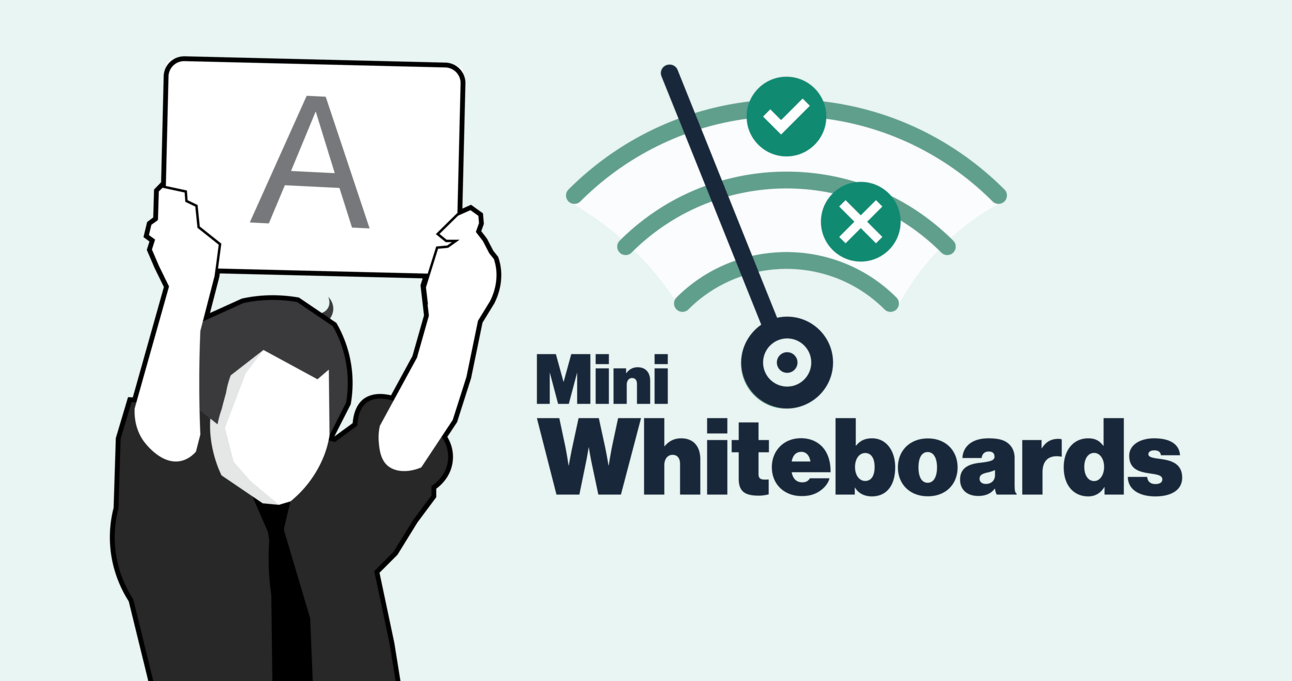⚗️ In this issue of DistillED, we're diving into one of the simplest, smartest tools for checking understanding and boosting participation: mini-whiteboards (MWBs).

What are mini-whiteboards used for?
Mini-whiteboards are small, erasable surfaces that allow students to write and share their thinking quickly and visibly. Instead of relying on hands-up questioning or assuming all students understand, MWBs give you a real-time, whole-class snapshot of student thinking.
Not only that, because MWBs are easily erasable and low-stakes, they encourage students to take risks. They create a fast, low-pressure feedback loop — helping teachers check understanding and adapt their teaching in the moment.
Here’s a quick distillation - MWBs help teachers to:
Diagnose Misconceptions: Catch misunderstandings early, before they become embedded in long-term memory.
Respond Quickly: Make better real-time decisions to adapt teaching and support students more effectively.
Increase Thinking Ratio: Engage every student in hard thinking, not just the confident few.
Strengthen Memory Retention: Use retrieval practice and give immediate feedback to help encode knowledge for long-term retention.
Why is checking for understanding so important?
One of the defining features of effective direct instruction is the ability to check for understanding continuously and purposefully.
According to Barak Rosenshine in Principles of Instruction (2012), checking for understanding is a hallmark of effective teaching. He found that master teachers frequently asked questions to check for student understanding after small chunks of instruction, rather than waiting until the end of the lesson. Without these frequent checks for understanding, teaching can become a guessing game — and students who are confused or develop misconceptions may slip through unnoticed.
“More effective teachers frequently checked to see if all the students were learning the new material. These checks provided some of the processing needed to move new learning into long-term memory. Less effective teachers did not.”
Relying solely on strategies like ‘hands-up’ leads to unequal and incomplete participation. As the image below illustrates, when teachers ask for volunteers and scan the class, only a handful of students (white dots) actively participate, while the majority of the class (green dots) remain passive, and some students (blue dots) disengage altogether. This creates an unreliable picture of what the whole class actually understands and risks leaving some students behind.

Diagram inspired by Bron Ryrie Jones - @BronRyrieJones
When used effectively, MWBs help establish a brisk, purposeful lesson pace while allowing you to check that ALL students are actually learning what is being taught. As a result, they enable teachers to adapt instruction responsively, ensuring that students are supported and guided to success.
How do I use mini-whiteboards effectively?
To make mini-whiteboards effective, the key is to embed them into your everyday classroom routines with a clear, consistent structure. By establishing this culture early, you create the conditions for MWBs to become an incredibly powerful tool.
The following structure is inspired by insights from the Checking for Understanding and Responsive Teaching webinar by Carl Hendrick and Haili Hughes. It combines a 5-part responsive routine with specific types of MWB checks to help surface thinking, target misconceptions, and adapt teaching in real time.
Stage | Focus | Example |
|---|---|---|
1. Plan Prepare questions before the lesson targeting different stages of thinking. | Target key concepts and potential misconceptions. Ensure answers can be written quickly (e.g., letter options for multiple-choice). | Misconception Check:"True or False: [intentional misconception statement]. Explain why." → Purpose: Diagnoses typical misunderstandings before they harden into memory. |
2. Pre-Lesson Check Gauge prerequisite knowledge at the very start. | Use simple questions to find out what students already know. This diagnostic step helps tailor your teaching immediately. | Baseline Question: "Write down one example of [previous concept]". → Purpose: Activates prior knowledge and surfaces gaps before new learning begins. Recognition Check: "Which option correctly defines [concept]?" → Purpose: Ensures students have basic understanding before building new knowledge. |
3. Teach with Checks Teach small chunks and check understanding frequently. | After each small input, use MWBs to ask a quick question. Look for common patterns of errors or confusion. | First Application: "Draw a simple diagram showing how [concept] works." → Purpose: Tests initial understanding through simple application. Analytical Questions: "What would happen if [variable] changed?" → Purpose: Tests cause-and-effect understanding. Common Misconception Checks: "True or False: [Misconception statement]. Explain." → Purpose: Diagnoses typical misunderstandings. |
4. Post Teach Check | Ask harder questions to check deeper understanding. Use this to decide whether to consolidate, move forward, or reteach. | Procedural Checks: "What’s the first step in solving this problem?" → Purpose: Tests procedural fluency and step-by-step understanding. Compare and Contrast Questions: "How is [concept A] similar to and different from [concept B]?" → Purpose: Strengthens conceptual links and flexible understanding. |
5. Follow Up Follow up immediately and adapt based on the success rate. | Aim for 80% success. If below 80% reteach the content. If above 80% move on or link to next concept. | Self-Assessment: "Rate your understanding from 1-4 and write one question you still have." → Purpose: Promotes reflection and highlights any lingering confusions. |
Where can I find out more?
One-Page Guide
The new Mini-Whiteboards guide is packed with practical strategies and simple routines to help you make the most of MWBs in your classroom.

Until next time — stay curious, stay clear!
Jamie
P.S. If this issue sparked something useful, feel free to forward it to a colleague or share it on social media.

